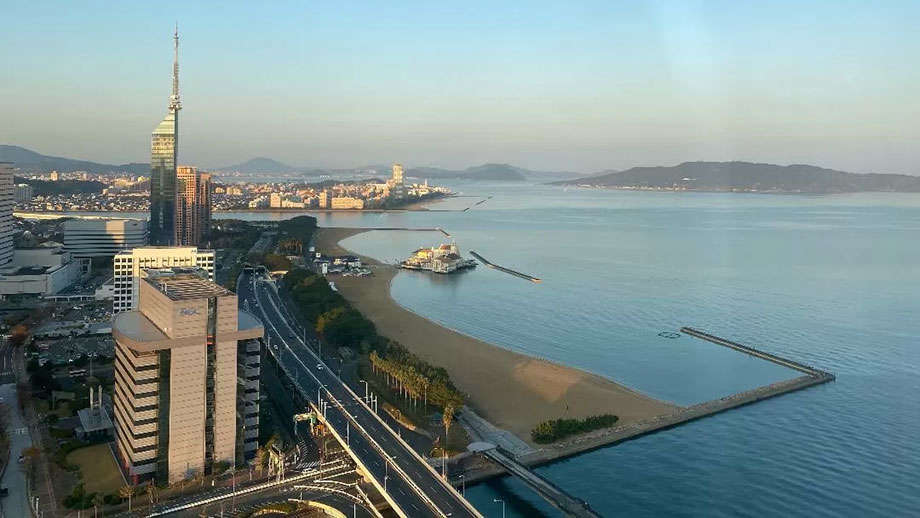
I received a lot of positive feedback on my last column where I introduced my prefecture, Fukuoka, so I am going to continue introducing other places of interest, but focus on Fukuoka city specifically, for this column.
Fukuoka City has a lot of charm and offers visitors much to see and do. Fukuoka is a big city with somewhat of a small town feeling. Even though it is one of the most populated cities, and is considered to be one of Japan’s major urban centers, it is consistently listed on top ten lists of great places to live and work anywhere in the world. I think this is due to its location, historical and cultural significance, great food offerings, hugeshopping malls, and fun nightlife activities.
In the 14 years I have lived here, I have witnessed a gradual increase in Japanese people relocating to the city and prefecture, as well as an influx of tourists visiting the city. That is both good and bad. Good that it is receiving revenue from all the domestic and international tourists, but bad for us locals who must deal with all the tourists that fill up restaurants and shopping malls, etc.
One huge advantage that Fukuoka has over other big, metropolitan cities is how convenient the airport is to the downtown area. Usually, airports are located far outside of the bustling areas of the city, but Fukuoka Airport is only two subway stops away from the main train station and downtown area, making it very convenient due to its easy accessibility. Flying into the city at night offers a bird’s-eye view of the lights and high-rise buildings that dot the city.

The airport recently underwent a huge renovation making it even more convenient to use. It also features many restaurants and shops that visitors can utilize before hopping on their flights to all parts of Japan. The international terminal is a bit less convenient, because passengers have to take a bus to the domestic terminal to catch the subway, but they have it organized nicely where little shuttle buses will ferry passengers back and forth. Just be sure to allow yourself enough time as it does take 20-30 minutes to get from the domestic terminal to the international terminal. International flights allow passengers to use Fukuoka as a hub to travel to all parts of Asia, Australia, and even Hawaii.

Many visitors like to visit “Fukuoka Tower” (photo) because it has been called the “best seaside tower in Japan” but I bet other cities make the same claim! It stands at a height of 234 meters (roughly 768 feet) and offers great panoramic views of the city and surrounding areas.

There are numerous commercial areas in Fukuoka City now, but one of the older ones that visitors enjoy is “Canal City” (photo above) which features not only a variety of shops and stores to buy clothing, souvenirs, etc, but also hotels, theaters, cinemas, and restaurants. The anchor hotel connected directly to the shopping area is the Hyatt Regency, and as expected, it has a number of high-end restaurants and shops available. Many Asian tourist groups especially come for the water fountain show that occurs on the half hour in front of the Hyatt. It is designed to be viewed from nearly every floor of the mall. Canal City seems to be more popular now with foreign tourists than the local people who live there.
Kushida Shrine is located very near the mall, which makes it a convenient location to visit, and due to its historical and cultural features, makes it a must-see place to visit when in the area. Boasting being one of the oldest shrines in Fukuoka (founded in 757), it is probably most well-known for the “Hakata Gion Yamakasa Festival.” One of the annual floats is always displayed on the grounds so visitors can see up close the type of float that is used during the summer festival. (see photo) Visitors also make a point to drink the well water that is surrounded by three cranes. Drinking from this well will allegedly extend your life, as a sort of “fountain of youth.” Around the shrine are a variety of displays that can be viewed, as well.
The Sumiyoshi Shrine is another must-see shrine in central Fukuoka. It is widely regarded as being the birthplace of all Sumiyoshi Shrines found in Japan, and the Fukuoka shrine is believed to be the home of the god for safe ocean travel and ships. The shrine complex is quite expansive and it will be hard to believe you are in the center of a big, bustling city when inside because it is so meditative and peaceful.

Another temple and shrine complex in the city center I always take guests to is the Touchoji Temple (photo) that features a pagoda, large wooden Buddha statue, and a number of other related landscape displays. Behind the giant Buddha, visitors can walk through “hell” which features a collection of illustrations representing hell and a chance to walk under the Buddha in total darkness. A railing is provided to guide you to the exit. Not recommended for people who panic in total darkness, of course.

This temple complex is especially beautiful during the cherry blossom season as it has numerous trees that have beautiful and full foliage when in full bloom.(see photos) This temple dates back to 806. The temple is the head temple of the Shingon sect of Buddhism, and it is the oldest temple of its kind on Kyushu Island.
This column was another sampling of some of the wonderful things Fukuoka has to offer visitors, but again, I have only scratched the surface. There are many more interesting places and things that can be found here, so those will have to wait until a future column.




